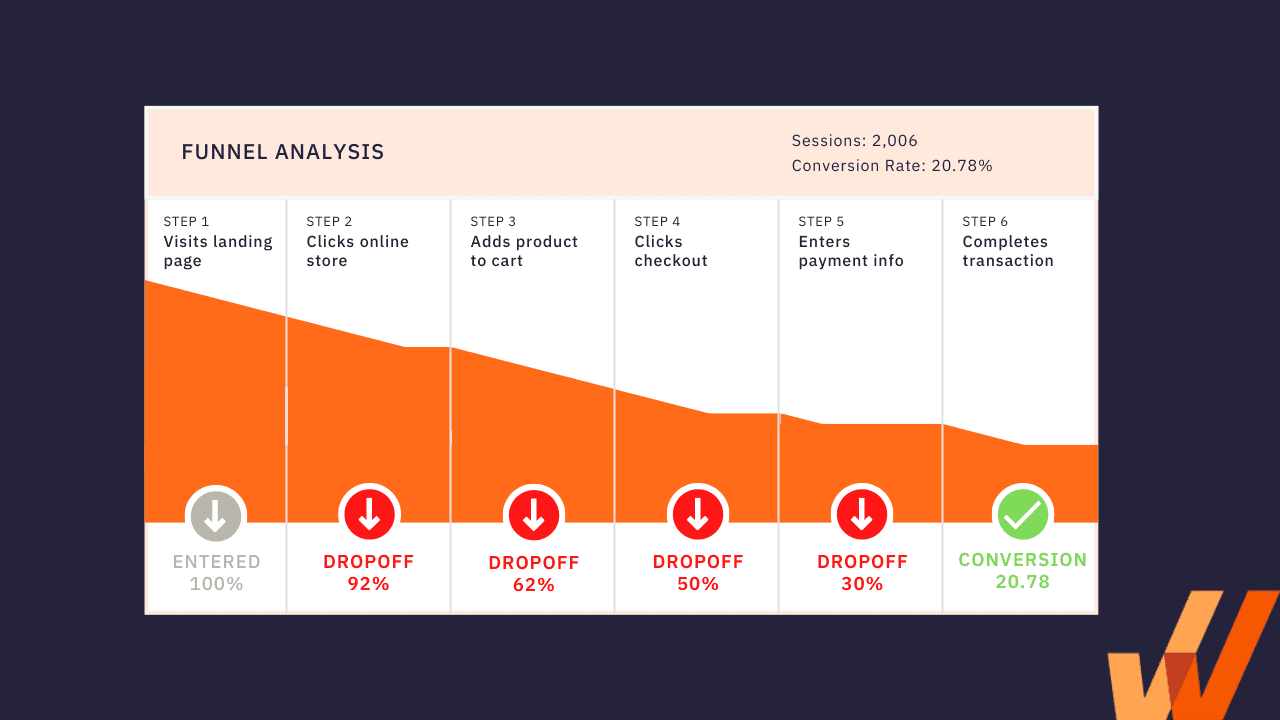As a Product pro, you’re always strategizing how to enable new users from their first session to achieve tangible value quickly. The faster and more effectively you do this, the closer you are to building sticky products that provide real customer value, driving retention, renewals, and account expansions.
That journey begins with your new user onboarding flow.
Your user onboarding strategy is where users form their initial impressions about your product, its UX, and its value. How you guide users impacts your entire product usage funnel and essential business metrics, like free trial conversion, active users, retention, and revenue.
But how do you know if your onboarding flow is healthy and optimized? How can you be agile and find opportunities for fast, practical new user onboarding improvements? First and foremost, you must track the right metrics. This means knowing the key metrics that indicate new users are completing their onboarding experience and guiding users to experience their “aha!” moment.
In this article, we’ll walk you through the critical user onboarding analytics and KPIs to track and measure to get a clear picture of your onboarding health and effectiveness and provide actionable insights on improving it.
We’ll also discuss how product teams can use Whatfix DAP and Whatfix Analytics to track custom user actions and behavior. Then, using these insights, they can take a data-driven, agile approach to improving user onboarding and product tours.
What are important metrics to measure user onboarding impact?
The Importance of Measuring User Onboarding Metrics
You’ve sold a new user the benefits your product can provide, but now it’s time to deliver the results. The new user onboarding experience is your opportunity to showcase how your product can solve challenges and drive outcomes for your users.
During the user onboarding process, your team needs to come together to ensure that users are appropriately educated on how to use your tool, what it can do for them, and that they have a positive experience working with your company.
Product teams can do that by following user onboarding best practices and having a user behavior analysis strategy in place. Analytics help you measure your onboarding flows’ effectiveness at driving product adoption and setting your new users up for success.
Measuring user onboarding can help you:
- Identify gaps in your onboarding process that may contribute to user frustration, product friction areas, and overall confusion.
- Reduce complications and pain points to reduce customer churn.
- Find opportunities to connect or engage with new users to build stronger relationships.
- Understand what areas of the onboarding checklist are consuming the most of your user’s time and attention.
- Optimize your onboarding process to achieve higher user adoption rates.
With this onboarding data, you gain valuable insights into the strengths and weaknesses of your user onboarding process and can use the data you’ve captured to make changes to improve it. This helps you increase user engagement, reduce churn, and improve the overall success of your product, whether it’s a simple B2C mobile app or a complex B2B SaaS product.
12 Must-Track User Onboarding Metrics & KPIs
While every product, website, or service will have contextual metrics and KPIs tied to their unique business goals and outcomes, there are common new user activation and product adoption metrics every team should track, benchmark, and analyze. Here are twelve must-track user onboarding metrics:
Here are twelve of the essential user onboarding metrics to measure your new user experience success:
1. Onboarding completion rate
The onboarding completion rate is the percentage of users who begin and finish your onboarding flow. Overall, it’s reasonable to conclude that if your completion rate is healthy and specific iterations are raising it, you’re successfully communicating to your new users that your platform has significant value.
Another way to consider the significance of your completion rate is that those who finish your onboarding are most likely to continue as customers. Simply put, this is where the user journey truly begins.
TIP: With Whatfix DAP, understand how users engage and consume your in-app guided experiences. For more advanced user onboarding analytics, Whatfix Product Analytics provides no-code event tracking to set up and track and custom user action.

2. User retention rate
Your user retention rate is the % of users who continue using your platform within a given period. For example, a 73% monthly retention rate means that 73% of your users stick around for their first month.
Looking at your earliest user retention rates is useful for evaluating the effectiveness of your onboarding. For example, looking at your week 1 retention is recommended: What percentage of users stick around for their first week on the platform?
Since their first week is close to when they’re exposed to your onboarding, your retention rate within the first week can give you a clue as to whether or not your onboarding is making users excited about moving forward in their user journey.
3. User engagement rate
The user engagement rate is another useful metric that measures the frequency with which your users actively engage with your platform in a given time period. Here, you’re looking for users taking meaningful actions that indicate they’re achieving value or are well on their way.
Here, too, the percentage of users meaningfully engaging with your product within the first week or two indicates how well your onboarding creates awareness around your key features and their value proposition.
PRO TIP
You can use Whatfix to create a Product Tour of your platform as soon as users enter your product for the first time. This helps create awareness and excitement about critical features, guides new users to set up their profiles correctly, and is a simple way to increase your user engagement rate early on in the user journey.

4. Free trial conversion rate
The free trial conversion rate measures the percentage of users who begin with a free trial and become paid users. Free trial conversions are generally a very important metric when it comes to overall revenue goals and here, too, onboarding is a crucial tool for increasing this number over time.
During your onboarding, you want to give your new users a full sense of the short—and long-term potential of using your platform so that even if they’re just starting to get their hands dirty during the free trial, they have enough of a sense of the long-term value. You’ll find that many of your onboarding initiatives, when successful, will positively influence your free trial conversion rate.
PRO TIP
Introducing users to a platform Task List within your onboarding using Whatfix is a great way to whet a user’s appetite for moving forward after their trial period. The task list can motivate users from the get-go to explore well beyond what they manage to do during their trial.

5. Time-to-value (TTV)
Time-to-value (TTV) is the average amount of time it takes your new users to move from their onboarding to getting genuine value from your platform. Your team needs to decide which events or actions constitute an indicator of value, and your onboarding flow plays a huge role in keeping this metric healthy.
To shorten the TTV, your onboarding should give clear and compelling information that guides users to the platform’s actions that bring the most value.
6. Feature adoption rate
Your feature adoption rate measures the percentage of users who use a specific feature regularly. As a Product team, you likely have a good idea of which features are most closely associated with increased revenue and better user retention. The more users who utilize that functionality regularly, the more likely you are to hit your goals.
Onboarding plays a key role in feature adoption because it’s your first chance to both wow and guide your captive audience of new users in their journey toward the regular use of key functionality on your platform.
PRO TIP
With Whatfix, create guided Flows that walk users step-by-step through your core and advanced features. This enabels new users to realize the value of your tool and quickly extract value. Use Flows over time to drive the adoption of advanced features to build power customers and leverage in-app Pop-Ups to announce new features.

7. User activation rate
The user activation rate tells you what percentage of your users get to key activation points in the user journey that will increase the likelihood of their long-term retention.
For example, if you know that generating a report is a key activation event in the user journey, your activation rate for generating a report will be particularly insightful. Onboarding is a key tool for guiding your users to move sooner rather than later to do certain actions that you know are important—watch this metric improve as you make onboarding iterations.
8. New user support ticket rate
Your new user support ticket rate measures the percentage of new users who write to support early in their journey. When your users write to support, it means they lacked the awareness and knowledge they needed and couldn’t find it elsewhere. What does this amount to? Friction, is the enemy of a good user experience, especially when a user is still forming their initial opinions about a new-to-them platform.
Your onboarding can play a key role in decreasing your new user support ticket rate by making sure that you offer new users key information about functionality that they’ll encounter when they enter the platform, and by letting them know where they can find your knowledge base if they need some extra help.
PRO TIP
With Whatfix, enable your users with Self Help, an in-app support center that empowers users to find answers to any contextual support issue they’re facing. Make sure to make it clear in your onboarding where users can find your in-app support to encourage its use.

9. Churn rate
Your churn rate measures the percentage of users who leave or disengage from your platform during a specific period of time. For example, your monthly churn rate will tell you what percentage of users leave or disengage during their first month of usage.
Churn can be caused by many factors, but two of the most common causes of churn are overall friction in the user experience and taking too long to reap value from the platform (remember TTV).
An informative and engaging onboarding experience can help decrease the churn rate. Whenever you make iterations to your onboarding, examine how each affects churn.
10. User onboarding funnel analysis
Funnel analysis is a process used to understand each step of the onboarding funnel better. The goal is to find specific parts of the process where users might drop out.

You can analyze your funnel by breaking your onboarding process into clear phases. Measure the number of users that move between each phase. It’s expected that a few will drop out at various points in the process, but if there is a significant jump between one phase and the next, it could point to an issue with that phase.
Use funnel analysis to identify the areas you need to zoom in on. You’ll want additional metrics or analytics to get a complete picture of your users’ behavior, but funnel analysis can point you in the right direction of where to start.
TIP: With Whatfix Analytics, create user Funnels to measure onboarding completion rate and identify where dropoff is occurring for new users. Use these insights to make data-driven improvements to your user onboarding flows.

11. DAU, WAU, MAU
Daily active users (DAU), weekly active users (WAU), and monthly active users (MAU) tell you how many customers are engaging with your product during that period.
Knowing how active your users are giving you a good representation of how well your product meets their needs, and how often they require your services. How you define an “active” user is up to you — but it might include completing a specific activity or engaging with a particular feature.
As an onboarding metric, you can see how different onboarding strategies or plans enhance (or diminish) your number of active users. Better onboarding could encourage users to engage with your platform more frequently.
12. NPS
Net promoter score (NPS) measures customer satisfaction and how likely they are to advocate for your brand through product feedback. Your NPS is found by surveying your customers on how likely they are to recommend your product to someone in their circle.
If your average NPS score is too low, it’s a sign that your users aren’t delighted. This isn’t always an onboarding issue, but it could point to a lack of clarity or understanding of how to get the most out of your platform.
Get a better picture of your NPS by breaking users into different segments or categories. This will help you identify which users may need additional support and which are already happy with the way things are.
TIP: With Whatfix DAP, create and launch in-app surveys to collect user feedback for onboarding-related surveys, NPS surveys, and more.

How to Measure & Improve User Onboarding With Analytics
Product analytics empowers product teams with the insights to measure and analyze their user onboarding flow, understand its effectiveness, and take a data-driven approach to improving it. Here are ten steps to help you get started collecting user onboarding analytics data and how to use it to improve your new user experiences.
1. Identify friction points in your user onboarding flow that cause dropoff
When you use product analytics software like Whatfix Product Analytics, product teams can use a no-code platform to set up custom events and track user behavior or actions. This allows you to easily see where in your users’ onboarding journey they typically drop off.
These drop-off points tell you where user friction occurs and are huge opportunities to test new onboarding experiments and flow iterations that can decrease abandonment or dropoff and keep your users moving through your onboarding funnel.
2. Map your new user onboarding journey
Rather than examining every step of user onboarding in isolation, using a data platform to holistically examine and plan the onboarding journey is key. Doing so lets you and your team understand where you can make meaningful product and UX changes that affect your onboarding KPIs.
When mapping out the user onboarding journey, the potential value for your team is limitless. For example, you can ensure that you’re doing enough in your onboarding flow to move users quickly to key activation events that you can work to improve on over time. You can take a micro-view at certain stages of the journey and work on improving the conversion from one step to the next.
3. Create funnel goals for your new user journey
When you use a data platform like Whatfix Product Analytics to visualize and measure your new user funnel, you can create nuanced goals to help guide your team toward product initiatives that move your new users down the funnel from newbies to active users. This will also allow you to zoom in on where dropoff is occurring and take a data-driven approach to improve your new user onboarding experience and rate of completion.
4. Identify your product’s “aha!” moment for different types of users
The ‘aha!’ moment may sound silly, but it’s not trivial: this is the action or event that a user does on your platform that usually seals the deal in terms of them becoming active users and getting value from the platform. It’s the part in your new user funnel where you know that if a user makes it to this point, we’ve hooked them.
Not all users are the same. The aha moment may come at one point for one segment of users and at a different point for other segments. Once you identify the aha moment for different user segments, you can personalize their onboarding experience to get them moving fast toward the one that makes the most sense for them.
5. Guide users to this “aha” moment with in-app experiences like Tours, Flows, and Task Lists
So you’re sold on giving specific user segments guidance for reaching their aha moment faster in your onboarding flow – but how exactly do you do that? With a digital adoption platform like Whatfix, product teams can leverage a no-code platform to create branded in-app experiences like Tours, Flows, and Task Lists to create a more effective, use-case-centric onboarding flow. This ensures users are moving toward their aha moment with all the necessary knowledge.
6. Track Tours and Task List completion rates
You’ve created Tours and Task Lists in your onboarding experience – but how do you know if they’re helping your users get value from your platform? Within Whatfix, you can monitor your Tour and Task List completion rates. You can improve your completion rates by experimenting with iterations until you reach an optimal rate.
7. Monitor different feature usage to understand which drives higher user activation rates
When you’re paying attention to key user behavior metrics, you’ll be able to understand which features are more likely to improve your user activation metrics. You can use the Whatfix Product Analytics platform to track correlations like these easily and ensure you’re highlighting those key features in your onboarding.
Use this data to understand what features resonate best with different cohorts of users. Then, leverage in-app experiences like Task Lists and Flows to encourage new users in these cohorts to experiment using them – helping you nudge your new users to find value in your product’s core features quickly.
8. Launch experiments and conduct a/b tests to improve onboarding completion and user activation
The only real way to determine whether or not any product iteration has had the desired effect is to run an a/b test. Your mind is probably already spinning with potential onboarding changes that could increase the chances that your users finish the flow and are activated quickly. You can use the Whatfix Product Analytics Platform to analyze your tests and quickly conclude with the winning variants.
9. Provide continuous in-app assistance for advanced features
Users who can help themselves experience less friction, and it’s important to keep an eye on your new user support ticket rate to ensure that your new users have a smooth initial experience. You can use Flows on the Whatfix Digital Adoption Platform to guide users post-onboarding, with in-app guided experiences for more complex features to convert free users to paid accounts, drive account expansions, and upsell your users with product-led growth.
10. Provide in-app resource centers and monitor where customers are experience friction
Well before your users finish their onboarding, they should be aware of where to go for help. You can use the Whafix Digital Adoption Platform’s Self Help feature to ensure new users know where to go when unsure by providing them an in-app support center always available to them.
Self Help integrates with your customer training resources, FAQs, knowledge base, and in-app Flows to provide a searchable help center that overlays your product UI. This enables new and existing users to overcome any support issue they have on their own, without requiring additional customer support assistance.
Software Clicks Better With Whatfix
Your onboarding is one of the most crucial tools for setting your customers up for success and reaping business value. To achieve optimal onboarding, you need a quality data analytics platform and a feature-rich digital adoption platform—and Whatfix has you covered.
Here’s a partial list of what you can do with the Whatfix Product Analytics and Digital Adoption platforms to achieve KPI-lifting user onboarding experiences:
- Welcome new users with in-app welcome Pop-Ups and Tours
- Create Task Lists for different types of customers to guide them through core features and activate new users.
- Use Flows to walk users through core features to drive adoption.
- Provide self-service in-app support to overcome user friction.
- Monitor user engagement and consumption of in-app experiences with Guidance Analytics.
- Track any custom user event with Whatfix Product Analytics.
- Analyze user behavior with Funnels, Goals, Journeys, and Cohorts.
- Use this data to improve onboarding completion rates, test new experiences, and drive adoption.
- Providing continuous in-app guidance to build power users and drive advanced feature adoption.













